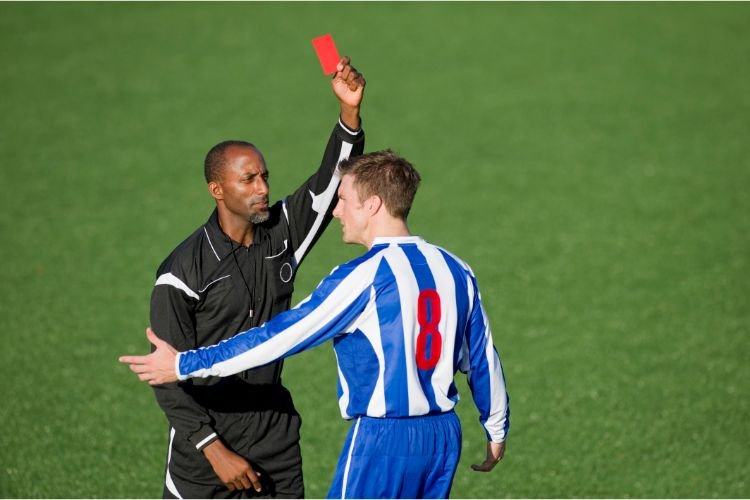Soccer is a beloved sport around the world, but it’s not without its controversies. One of the most contentious aspects of the game is the role of the referee and the rules surrounding fouls. In this article, we’ll dive into the regulations and best practices for soccer referees when it comes to fouls, so you can better understand the game and what’s at stake.
What is a Foul in Soccer?

Before we dive into the specifics of fouls, let’s first define what a foul is in soccer. According to FIFA, a foul is “an unfair or unsafe action” committed by a player that interferes with the game. The most common fouls in soccer include tripping, pushing, holding, and kicking an opponent, as well as handballs, dangerous tackles, and unsporting behavior.
Types of Fouls in Soccer
There are two main categories of fouls in soccer: direct and indirect. A direct foul is a more severe infraction that results in a free kick or penalty kick for the opposing team, while an indirect foul results in a free kick but not a penalty kick.
Direct Fouls
Direct fouls are more serious offenses and can result in disciplinary action, such as a yellow or red card. Here are some of the most common direct fouls in soccer:
- Tripping an opponent
- Pushing or shoving an opponent
- Jumping at an opponent
- Charging an opponent
- Spitting at an opponent
- Tackling an opponent from behind
- Handball in a dangerous area
- Denying a clear goal-scoring opportunity (this may result in a red card)
Indirect Fouls
Indirect fouls are less serious than direct fouls and generally result in a free kick for the opposing team. Here are some common examples:
- Obstruction (i.e., impeding an opponent without making contact)
- Playing dangerously (i.e., attempting to kick the ball while an opponent is in close proximity)
- Interfering with play (i.e., obstructing the goalkeeper’s line of sight)
- Goalkeeper handling the ball for more than six seconds
- Offside (when an attacking player is closer to the opponent’s goal than the ball and the second-to-last defender)
Best Practices for Soccer Referees
As a soccer referee, it’s your responsibility to ensure that the game is played fairly and safely. Here are some best practices to keep in mind:
Know the Rules
It’s essential to have a thorough understanding of the rules and regulations of soccer, particularly when it comes to fouls. FIFA publishes the Laws of the Game, which outline the rules and best practices for referees.
Stay Neutral
As a referee, you must remain impartial throughout the game. Avoid showing favoritism to either team, and make decisions based solely on the facts and the rules of the game.
Communicate Effectively
Clear communication is critical in soccer, particularly when it comes to fouls. Make sure to communicate any calls, warnings, or disciplinary action to the players clearly and calmly, so they understand the situation and can adjust their behavior accordingly.
Enforce the Rules Consistently
One of the most important aspects of being a soccer referee is enforcing the rules consistently. Don’t let emotions or outside factors influence your decisions. Consistency is key to ensuring that both teams have an equal opportunity to play the game and that players understand the consequences of their actions.
Be Visible and Assertive
As a referee, it’s essential to be visible and assertive on the field. Make sure you’re in a position to see all the action and that you’re confident in your calls. Don’t be afraid to blow your whistle or show a card if necessary.
Challenges Faced by Soccer Referees
Being a soccer referee is not an easy job, and there are several challenges that referees face on a regular basis. Here are some of the most common challenges:
Managing Player Emotions
Soccer can be an emotional game, and players can become frustrated or angry when things don’t go their way. As a referee, it’s important to manage these emotions and prevent them from escalating into more serious incidents.
Dealing with Aggressive or Unsportsmanlike Behavior
Sometimes players may act aggressively or engage in unsportsmanlike behavior on the field. As a referee, it’s your responsibility to address this behavior and take appropriate disciplinary action, such as issuing a yellow or red card.
Ensuring Fair Play
Another challenge faced by soccer referees is ensuring fair play for both teams. This means enforcing the rules consistently and ensuring that both teams have an equal opportunity to play the game.
Handling VAR Reviews

VAR, or video assistant referee, has become an increasingly common part of soccer in recent years. Referees must be able to handle VAR reviews and make decisions based on the technology’s input.
Conclusion
In conclusion, soccer referees play an essential role in ensuring that the game is played fairly and safely. Understanding the rules and regulations of fouls is crucial for referees to make informed decisions and enforce the rules consistently. By following best practices and addressing the challenges faced by referees, we can continue to enjoy soccer as a beloved sport around the world.

